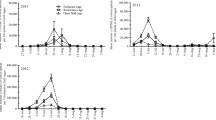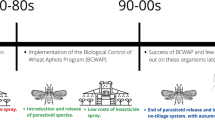Abstract
At the beginning stage of cotton aphids (Aphis gossypii Glover) invading the cotton field, large numbers of insects have accumulated in the marginal alfalfa (Medicago sativa L.) zone surrounding it. They are 6.94 times (excluded natural enemies) as many as the aphids in cotton field. Most of these insects areTherioaphid maculata (Buckton), and occur in fields 10–15 d earlier than cotton aphids. Consequently, abundant natural enemies have bred in alfalfa zone when cotton aphids increase rapidly in cotton fields in the middle of June in Xinhe County, Xinjiang Autonomous Region. The total number of the major natural enemies, including Coccinellids, Chrysopids and Syphid flies in alfalfa zone, is 13.65 times that in cotton field within the same acreage of fields. At this period, it is very effective to force the natural enemies from the alfalfa zone into the nearby cotton field to control the rapid increase of cotton aphid population by cutting the alfalfa stands.
Similar content being viewed by others
References
Slosser, J. E., Pinchak, W. E., Rummel, D. R., A review of known and potential factors affecting the population dynamics of the cotton aphid. Southwest Entomol., 1989, 14: 302.
Kerns, D. L., Gaylor, M. J., Biotic control of cotton aphid in cotton influenced by two insecticides, J. Econ. Entomol., 1993, 86(6): 1824.
Jones, C. G., Ostfild, R. S., Richard, M. P. et al., Chain reactions linking acorns to gypsy moth outbreaks and lyme disease risk, Science, 1998, 279(5353): 1023.
Ellington, J., Southward, M., Chnillo, T., Association among cotton Anthmpods, Environ. Entomol., 1997, 26(5): 1004.
Yan, Y. H., Broadening the scope of biological control by alternatives towards the sustainable pest management, Acta Entomologica Sinica (in Chinese), 1998, 41 (suppl.): 1.
Zhang, R. Z., Zhang, G. X., The importance of mutual plants in biological control of pests, Chinese Journal of Biological Control (in Chinese), 1998, 14(4): 176.
Zhang, R. Z., Zhang, G. X., A new way of the pest management: mutualistic plant prokction (MPP), Bull. Chinese Acad. Sciences, 1998, 12(3): 212.
Yan, Y. H., Duan, J. J., The effect of cover cropping in apple orchards on the predator community on the apple tree, Acta Phytophylacica Sinica (in Chinese), 1988, 15(1): 23.
Yan, Y. H., Yu, Y., Du, X. G. et al., Conservation and augmentation of enemies in pest management of Chinese apple orchards, Agriculture, Ecosystems and Environment, 1997, 62: 253.
Yu, Y., Yan, Y. H., A study on the plant diversity in apple orchards toward sustainable pest management, Acta Entomologica Sinica (in Chinese), 1998, 41(suppl.): 82.
Author information
Authors and Affiliations
About this article
Cite this article
Zhang, R., Liang, H., Tian, C. et al. Biological mechanism of controlling cotton aphid (Homoptera: aphididae) by the marginal alfalfa zone surrounding cotton field. Chin.Sci.Bull. 45, 355–358 (2000). https://doi.org/10.1007/BF02909768
Received:
Issue Date:
DOI: https://doi.org/10.1007/BF02909768




